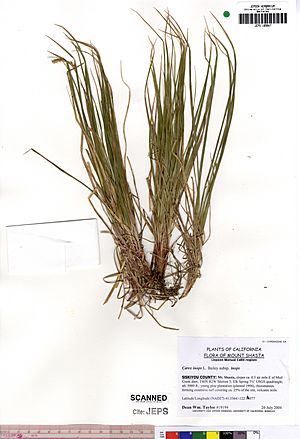Carex inops facts for kids
Quick facts for kids Carex inops |
|
|---|---|
 |
|
| Carex inops subsp. inops herbarium specimen | |
| Scientific classification | |
| Genus: |
Carex
|
| Species: |
inops
|
Carex inops is a type of sedge plant. People often call it long-stolon sedge or western oak sedge. It grows naturally across northern North America. You can find it in southern Canada and the western and central parts of the United States.
There are two main kinds, called subspecies. Carex inops subsp. inops lives only on the west coast. This includes places from British Columbia to California. The other kind, Carex inops subsp. heliophila, is also known as sun sedge. It is found in more places, especially east of the Rocky Mountains.
What it Looks Like
This sedge plant grows in loose groups of stems. These stems can reach up to 50 centimeters (about 20 inches) tall. Its leaves are stiff and narrow. Even when they die, the old leaves stay around the bottom of the plant.
The plant's flowers grow in a cluster called an inflorescence. Usually, the female flower parts (pistillate spikes) are below the male flower parts (staminate spikes). This plant grows from underground stems called rhizomes and also from fibrous roots. Even though its name includes "stolon," it usually does not form stolons, which are like runners that spread plants.
Where it Grows and Why it's Important
This plant, especially the sun sedge (C. inops subsp. heliophila), is a very important plant in many ecosystems. It is often a main plant in grasslands. On the prairies of the northern Great Plains, it grows alongside many types of grasses. These include western wheatgrass (Pascopyrum smithii) and big bluestem (Andropogon gerardi). Other grasses it grows with are needle-and-thread grass (Hesperostipa comata) and blue grama (Bouteloua gracilis).
You can find it on the tallgrass prairies of Kansas. Here, it grows with bluestems and prairie sandreed (Calamovilfa longifolia). It is also a main plant in meadows in the Rocky Mountains. It grows in woodlands in Nebraska, the Black Hills of South Dakota and Wyoming, and the plains of Saskatchewan.
This sedge can grow in grasslands at different stages of their natural changes, called ecological succession. It can even start growing in places like blowouts (wind-eroded spots), anthills, and prairie dog towns.
Many animals eat this plant, especially the sun sedge subspecies. Farmers and ranchers think it is good forage for livestock like cattle. This is because it is one of the first green plants to appear in the spring, and animals enjoy eating it.

